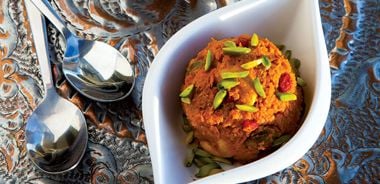Carrot and Pistachio Halwa

Vegetables for dessert? This delicious carrot halwa dessert is often eaten all by itself without an entrée or meal preceding it. We took a bit of creative licence with the traditional halwa and substituted coconut milk for regular milk and raw coconut crystals for granulated sugar. The results are delicious! Try our version and eat it hot, warm, or cold.
1/4 cup (60 mL) raw cashews
2 Tbsp (30 mL) shelled unsalted pistachios
3 cups (750 mL) peeled and finely grated carrots
1 cup (250 mL) coconut milk or regular milk
1/2 cup (125 mL) raw coconut crystals* or coconut sugar
Generous pinch of ground cardamom
2 Tbsp (30 mL) barberries** OR 1/4 cup (60 mL) golden raisins
1 Tbsp (15 mL) finely chopped shelled pistachios
Sea salt (optional)
Dry roast cashews and 2 Tbsp (30 mL) shelled pistachios in small frying pan over medium heat until lightly toasted and aromatic. Shake pan over heat several times to prevent them from burning. Remove and place them in small dish.
Combine grated carrots and milk in medium-sized saucepan. Stir together and cook covered over medium heat for 5 to 7 minutes or until carrots are tender. Remove lid and continue to cook over medium-low heat, stirring frequently until milk has almost evaporated. Stir in coconut crystals or sugar, cardamom, and raisins, and continue to cook until sugar is dissolved and mixture is as dry as you like. Fold in toasted cashews and pistachios. (If using barberries instead of raisins, fold in with toasted nuts.) Add a pinch of salt if you wish.
Serve a small 1/4 cup (60 mL) scoop in a dessert dish with a dusting of finely chopped pistachios. Serve hot or warm, or refrigerate and serve cold.
* Raw coconut crystals are available in health food and organic food stores. They’re a low glycemic sugar alternative and have a delicious full sweetness without all the calories of regular sugar.
** Barberries are available in most Iranian grocery stores.
Serves 6.
Each serving contains: 209 calories; 2 g protein; 11 g total fat (8 g sat. fat, 0 g trans fat); 28 g total carbohydrates (21 g sugars, 2 g fibre); 43 mg sodium
source: "Persian Cuisine", alive #377, March 2014





